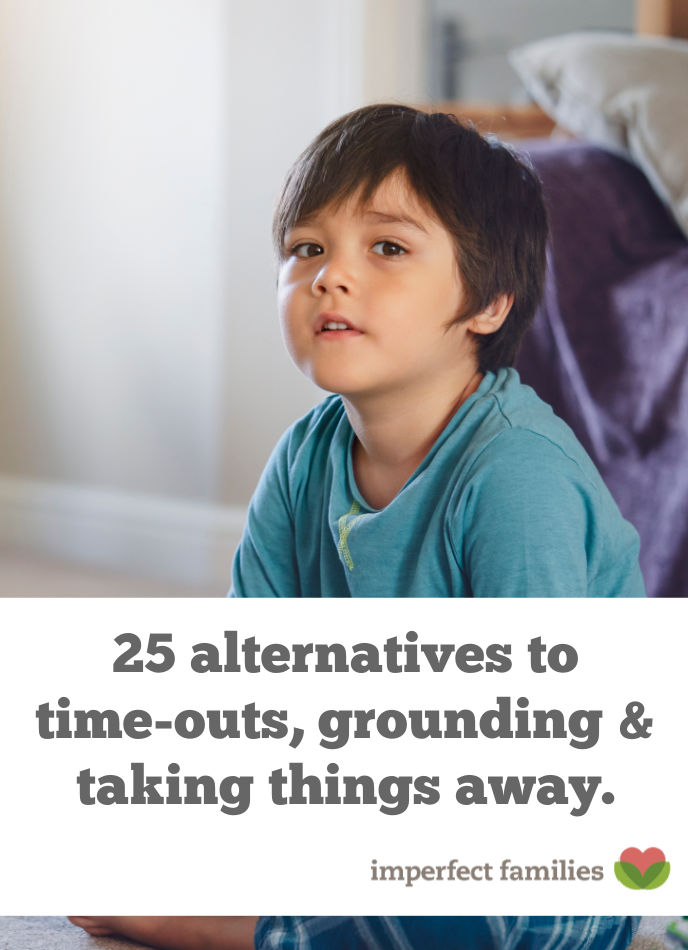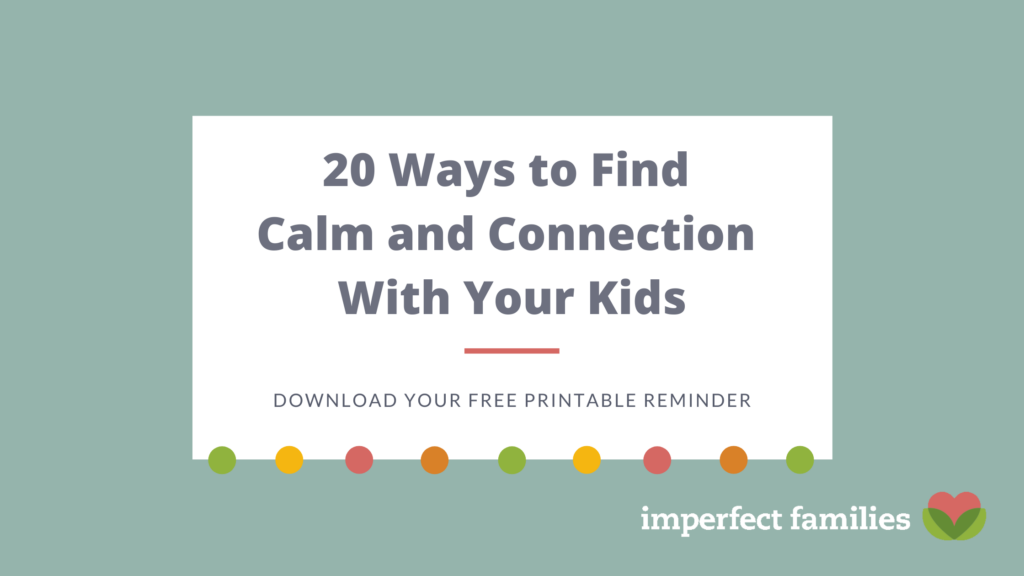Change the way you think about discipline! These 25 parenting tips focus on positive, respectful, age-appropriate alternatives.

When it comes to discipline, it’s easy to feel stuck.
We’re told to use timeouts, grounding, bribes, taking things away, and even spanking, but nothing seems to make a difference.
Maybe we’ve been thinking about discipline all wrong.
Rather than trying to find ways to “control” our kids or “force” them to comply with our demands, what if we saw ourselves as calm, confident teachers?
What if we focused more on how to support and guide our kids in a developmentally appropriate way?
What if we started thinking about self-regulation as a process that takes decades, not weeks? Recognizing that it’s normal for kids to have good days and hard days – just like we do.
If you’re willing to see discipline through a different lens, this list is a place to start.
As you shift your focus, you may start to see discipline less as something you do in the heat of the moment, and more as a relationship. A way of “being” with your kids – when things are going well and when things are difficult.
Choose a few techniques to try and ignore the rest. Do not feel pressured to use every technique or idea. As long as you are striving towards teaching with a calm confidence, you are headed in the right direction.
25 Alternatives to Timeouts, Grounding and Taking Things Away
Start With You: We cannot expect our kids to be more mature than we are, so begin to acknowledge where you feel stuck. Name your triggers. Practice calming strategies. Reach out to a mental health professional or a supportive community. We all have growth areas to work on, be kind to yourself as you notice, practice, and try something new. Check out my book “It Starts With You.”
Speak Calmly: Regardless of the parenting technique, using a calm or neutral tone is a great choice. Not only does it help you stay calm, but it may also encourage your child to respond in a calm manner. If you’re having trouble speaking calmly, take a few deep breaths before saying anything else out loud.
Be Empathetic: Listen to what your child is saying, then repeat or paraphrase it back to them. If you heard them wrong, your child will correct you. Paraphrase this correction back to them. This is not always as easy as it sounds, as we often switch to problem-solving, rationalizing, or correcting. Stick with it until your child feels that you really understand what they’re trying to say.
Listen: This is another seemingly simple solution that is hard to actually implement. Be aware of your instinct to interrupt, suggest a solution or formulate your response before your child is done speaking. Focus on what they are saying and go back to empathy as often as needed to show you are truly listening.
Get Low: Getting below your child’s line of sight can greatly reduce the possibility of a tantrum or meltdown. Getting low keeps your child’s brain from feeling threatened, signaling the “fight or flight” response. Combine this technique with empathy, listening and calm responses.
Decrease the Sensory Input: In the heat of the moment, the brain is flooded with information and everything – even comfort and kindness – can be (mis)interpreted as a threat. Quiet your voice, or stop talking altogether, sit close but do not make physical contact, slow down, rather than trying to rush your child back to calm.
Limit the Lecturing: Kids are experts at tuning out a lecture, even if you are coming from a well-meaning place. Instead, be open to having a conversation. That means hearing their side of the story, even if you don’t agree. Model how to disagree respectfully or work towards a mutual solution.
Time-In: Rather than sending your child to another room for a time-out, bring them closer to you. Create a safe space for them to feel their feelings under your supportive protection. Some children may benefit from having your undivided attention for just a few minutes before heading back to play.
Name Emotions: Move beyond “happy,” “sad,” and “mad” by introducing complex emotions like jealous, irritated, bored, stressed, and overwhelmed. Talk about how it feels in their body and how it looks on their face. Let them know it’s normal to feel “mixed up” feelings or more than one feeling at a time.
Offer a Hug: Encourage your child to refocus and get back on track with the help of physical interaction. A tight (but not painful) bear hug, a “you-can-do-it” reassurance hug, or an “I-can-see-you’re-struggling” snuggle can take a child from meltdown to calm.
Give Choices: This starts with “Do you want a red cup or a blue cup?” but it can extend to “Do you want to do your math or your spelling first?” Think of ways to give your child the power to make a choice instead of deciding for them. Sometimes there is only one choice, i.e. “you must sit in your car seat,” but do your best to limit the non-negotiables.
Set a Timer: Timers are great for “beat the clock” races, letting kids know when their time is up, or setting limits on activities. Download a countdown clock or kiddie timer to provide a visual representation of how much time remains.
Make it a Game: Most kids would rather be encouraged to throw their dirty socks into the hamper like a basketball rather than being yelled at to clean up their laundry. If you can create a challenge or game, you might find you also get faster and more cheerful compliance.
Give Fewer Commands: No one likes to be told what to do, especially if it’s repeated all day long. If you feel like your child is ignoring you, try reducing the number of reminders, commands, and demands you give. Focus on giving encouragement, noticing the positive, and pointing out what they are doing right.
Simplify rules/expectations: Sometimes the rules get too complicated. If you find it hard to remember your expectations or if there are too many steps to compliance, simplify. Rather than listing, “No hitting, kicking, spitting, slapping, etc.” create a family expectation of “respecting personal space.”
Prioritize one-on-one time: Proactively filling your child’s need for connection with you can minimize the amount of attention-seeking behavior in the future. Spend 10-20 minutes with each child per day, doing something they enjoy. Focus on being present with them, resist the urge to use this time to discuss misbehavior.
Change the Environment: Tired of coats on the floor? Install hooks at a child’s height. Tired of kids eating junk food instead of fruit? Stop buying junk food or make it less accessible. Examine the environment from a child’s perspective and see if there is a way to make it easier for them to comply.
Make a Routine: Instead of reminding and prompting, work with your kids to create a routine that makes sense. Create a visual schedule using pictures for pre-readers. Stick to the same routine as often as possible. Children feel a sense of security knowing what is expected and what is coming next.
Teach: How does your child learn best? Are they a hands-on learner? Are they a visual learner? Do they need the steps broken down or explained in a different way? Encourage independence by asking your kids to teach you about a topic (bullying, cheating, etc.) or tell you the steps to complete a task (loading the dishwasher, feeding the dog, etc.).
Be Curious: Your child’s ability to regulate their emotions depends on a number of factors, as well as age and developmental stage. Hunger, thirst, over/under-stimulation, disconnection from caregivers, and lack of sleep can all impact behaviors. After a challenging event, ask “why” the behavior occurred and explore what was going on in your child’s day, their environment, or their experience.
Practice When Calm: Resist the urge to force your child to learn something new or take a deep breath in the heat of the moment. Wait until you both are calm. Bring up the subject in a calm, non-threatening manner. Talk about alternative ways to deal with the problem and practice together. Keep it short and light-hearted.
Brainstorm Solutions: If something’s not working for you, start a conversation about it, exploring solutions together. Your child may come up with a solution you never considered. If it seems reasonable, give their idea a try. If it doesn’t work, re-evaluate and pick a different solution.
Let them Feel Feelings: It is OK for your child to experience sadness, frustration, disappointment, and anger. Rather than rescuing them by giving in, offering a bribe, or giving a punishment, be present and supportive. Offer them your calm, confident presence, sending the message: “You are not alone. We will get through this big feeling together.”
Delay The Answer: Many parents feel put on the spot to find the “perfect” response in the heat of the moment. Give yourself a break. Instead, focus on getting (or staying) calm. Take a break, if needed. Let your child know that you will talk more about this when you both are calm. There’s no hurry. You will be able to think more clearly and work together more productively if you discuss it again later.
Let it Go: There is so much pressure to raise good children who behave perfectly and never misbehave. The pressure is not only unreasonable, but it’s also impossible. We are all imperfect; we all make mistakes (adults included). Your child is going to meltdown because they are disappointed, they are going to be frustrated that they can’t have another ice cream cone, and they may even flunk a math test. If you’re focusing on finding a consequence or punishment for these behaviors, you’re missing the point. Help your children learn from these experiences and make different choices next time.*
*Please note: you do not have to excuse physical or emotional violence either from your child or another adult. If you are in an unsafe situation, please seek support or call 911. If you feel that your child struggles with anxiety, frustration, anger, sadness, or another behavior more than other children their age, they may benefit from the support of a mental health professional. There is no shame or judgment for getting your child the help they need.
How Can I Help?
If you find yourself struggling to discipline differently, you are not alone. It is hard to change patterns of behavior, especially if we do not have a good role model from our own childhood. Parent Coaching provides education, support, and encouragement as you begin to implement new parenting techniques.



Comments have been turned off to retain the privacy of all families. If you have a question or comment on the topic, you're always welcome to contact me.